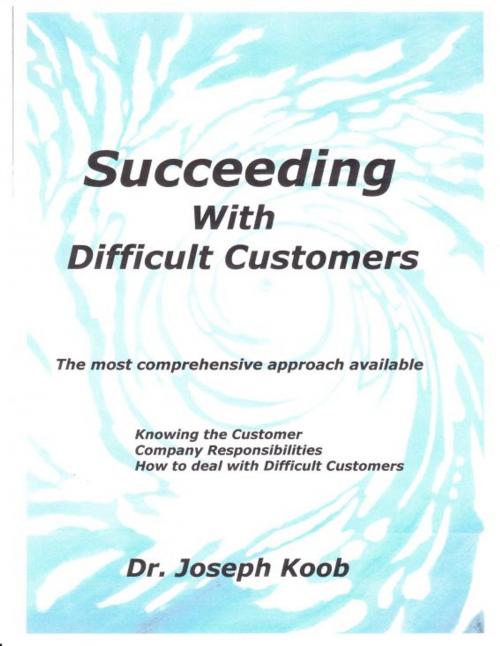Succeeding with Difficult Customers
Business & Finance, Marketing & Sales, Customer Service, Nonfiction, Health & Well Being, Self Help, Self Improvement, Success| Author: | Joseph Koob II | ISBN: | 9781301087471 |
| Publisher: | Joseph Koob II | Publication: | September 28, 2012 |
| Imprint: | Smashwords Edition | Language: | English |
| Author: | Joseph Koob II |
| ISBN: | 9781301087471 |
| Publisher: | Joseph Koob II |
| Publication: | September 28, 2012 |
| Imprint: | Smashwords Edition |
| Language: | English |
"Succeeding with Difficult Customers" is for anyone who is in contact with customers on a regular basis: clerks, sales personnel, customer service representatives, phone service representatives, managers who are in the customer contact loop, and so on. It is also for those business owners and company executives who want to gain insight into what is really important for them and their representatives to know about working with difficult customers. Therefore some sections of this book will focus more toward those who work directly with customers, while other sections speak more toward managerial responsibilities. There IS considerable overlap because all of this information is valuable to anyone involved in dealing with customers. Most importantly this entire book is about customer service, and the many key ideas that make or break what happens out in the real world where personnel interact with customers every day.
While many businesses do provide training in how their personnel approach customers in a positive and gracious manner, there are other important knowledge and skill development areas that are often left to chance. Unfortunately the focus is often fairly one way – how customer service personnel interact with customers, i.e. their overall demeanor. This book takes the learning into several other important dimensions of customer service as well: Knowing and Understanding the Customer; Communications; Dealing with Difficult Customers; and the training and support these customer contact personnel should be receiving.
We will present information that will give you extensive insight and knowledge into the customer’s perspective, i.e., what you need to know as a company representative to do your job successfully, the internal and external support you need, and the tools and skills to communicate effectively with difficult customers.
I have held a wide variety of jobs in my life, from sales to service to managerial. There is one overriding truth that comes from all of this: people are people and want to be treated fairly and considerately. When I am engaged with a company’s representative I often think in terms of, “What is happening here that is good?” and “What is not happening here that should be happening?” It is important to keep in mind that knowing what the customer thinks, and how he or she feels, is essential to your being at the top of your game as a person who works with customers on a regular basis. It makes all the difference as to whether that person will consider doing business with your company/establishment in the future and how he/she will communicate their feelings and experience to others.
What I hope you will gain from this book is an understanding of the wide scope of effective knowledge, tools, and skills that are available to you for dealing with people, even difficult people, on a daily basis. Your company will hopefully provide more specific information on what is critical to their approach to customer relations, their general operations, and their customer base.
It is our wish that your well-being and enjoyment of work and life may be more fulfilling as a result of this book.
"Succeeding with Difficult Customers" is for anyone who is in contact with customers on a regular basis: clerks, sales personnel, customer service representatives, phone service representatives, managers who are in the customer contact loop, and so on. It is also for those business owners and company executives who want to gain insight into what is really important for them and their representatives to know about working with difficult customers. Therefore some sections of this book will focus more toward those who work directly with customers, while other sections speak more toward managerial responsibilities. There IS considerable overlap because all of this information is valuable to anyone involved in dealing with customers. Most importantly this entire book is about customer service, and the many key ideas that make or break what happens out in the real world where personnel interact with customers every day.
While many businesses do provide training in how their personnel approach customers in a positive and gracious manner, there are other important knowledge and skill development areas that are often left to chance. Unfortunately the focus is often fairly one way – how customer service personnel interact with customers, i.e. their overall demeanor. This book takes the learning into several other important dimensions of customer service as well: Knowing and Understanding the Customer; Communications; Dealing with Difficult Customers; and the training and support these customer contact personnel should be receiving.
We will present information that will give you extensive insight and knowledge into the customer’s perspective, i.e., what you need to know as a company representative to do your job successfully, the internal and external support you need, and the tools and skills to communicate effectively with difficult customers.
I have held a wide variety of jobs in my life, from sales to service to managerial. There is one overriding truth that comes from all of this: people are people and want to be treated fairly and considerately. When I am engaged with a company’s representative I often think in terms of, “What is happening here that is good?” and “What is not happening here that should be happening?” It is important to keep in mind that knowing what the customer thinks, and how he or she feels, is essential to your being at the top of your game as a person who works with customers on a regular basis. It makes all the difference as to whether that person will consider doing business with your company/establishment in the future and how he/she will communicate their feelings and experience to others.
What I hope you will gain from this book is an understanding of the wide scope of effective knowledge, tools, and skills that are available to you for dealing with people, even difficult people, on a daily basis. Your company will hopefully provide more specific information on what is critical to their approach to customer relations, their general operations, and their customer base.
It is our wish that your well-being and enjoyment of work and life may be more fulfilling as a result of this book.















